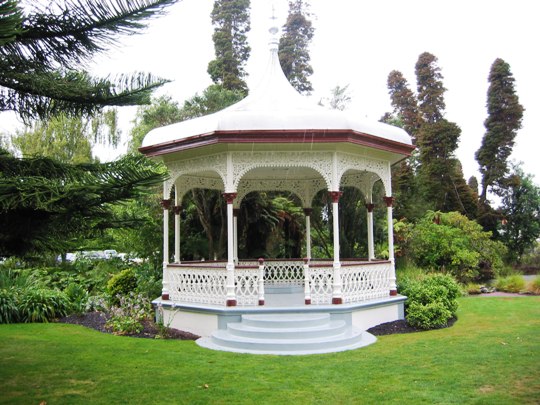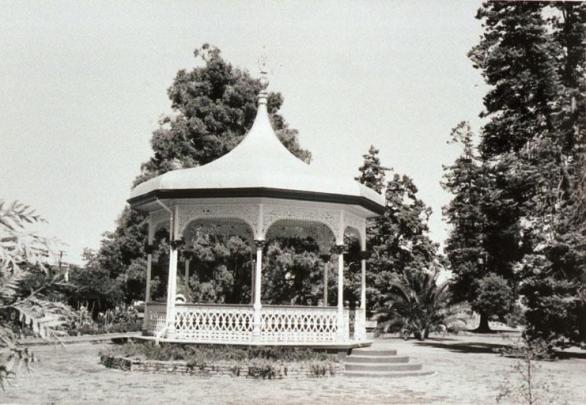The Rotunda was erected in Rotorua’s Government Gardens in 1900, in response to a changing emphasis for the Gardens, from sanatorium to health spa and leisure garden. Entertainment and the avoidance of boredom by patients, was considered a crucial part of a holistic treatment approach, and the music also added to the attraction for tourists. Both a European band (probably the Rotorua Amateur Brass Band) formed in the early 1890s and Maori band (Rotorua Maori Band) established circa 1900 to 1904, were employed to perform turn about, in the evenings, however, complaints by Wohlmann that the music was ‘too dull’ saw an orchestra engaged in 1909. The Band Rotunda has been relocated from its original site. It was erected approximately in the middle of where the current bowling club building is located and was moved to make room for this facility The structure was built utilising prefabricated iron work manufactured by Brinsley & Co., Dunedin. Originally sited near the current bowling club, it now stands a few metres south of the entrance to Queen’s Drive. An octagonal rotunda the sides are open, but quite decorative, composed of ornate cast iron elements with a low baluster with a base of fleur de lis alternated with circles containing four leaf patterns. The central section features concentric circles with a four leaf design at the intersection of the circles, and the top section has a foliated scroll pattern. Access is via four semi circular concrete steps flanked by timber newel posts. The octagonal ogee profiled roof is sheathed in aluminium supported by eight columns with Corinthian capitals. Rising from the capitals are ornate brackets and architrave with a foliated scroll pattern. The architrave supports a wooden frieze and cornice. The aluminium roof is topped by an ornate finial, which is a light fitting. The ceiling is constructed of tongue and groove timber with a central fretwork rosette. A low timber octagonal, band conductor’s stand is fixed to the centre of the rotunda floor. The landscaping was an important element in the finalising the erection of the Rotunda, with a rock collar formed around its base for cultivation of alpine plants. Although primarily used for band performances, it was used for time by the bowling club used it as a committee and refreshment room during tournaments. Architecturally, the Rotunda is a fine example of an ornate, Edwardian rotunda representative of a Government committed to invest generously in projects that might add another dimension to the Gardens, and further build its burgeoning tourism industry. The Rotunda is highly significant for its representation of New Zealand’s social history, through the evolving spa concept and the importance of entertainment as part of the Edwardian spa and Pleasure Garden ideal of the time. It represents early endeavours to provide what was considered a sophisticated ‘pleasure garden’ environment such as those known at spas in Europe. Scientifically it was introduced as part of a holistic approach to treatment regimes put in place by the first Government Balneologist, Dr Arthur Wohlmann. There is historic importance in Government employing the Rotorua Maori Band, given its determination that Maori cultural experiences were an important part of the tourism mix in Rotorua.



Location
List Entry Information
Overview
Detailed List Entry
Status
Listed
List Entry Status
Historic Place Category 2
Access
Able to Visit
List Number
789
Date Entered
4th April 1983
Date of Effect
4th April 1983
City/District Council
Rotorua District
Region
Bay of Plenty Region
Legal description
Pt Lot 3 DP 15998 (RT SA34C/324) (Recreation Reserve NZ Gazette 1984 p 2272), South Auckland Land District
Location Description
Enter the Gardens at Queens Drive, it is to the right, just past the Te Runanga Building. Located beside the ornamental pond and garden.
Related listings
Stay up to date with Heritage this month
